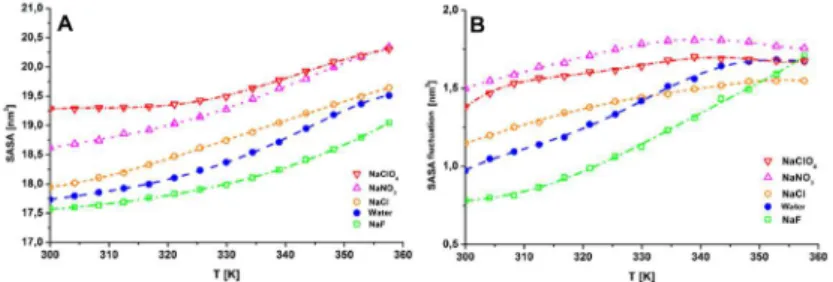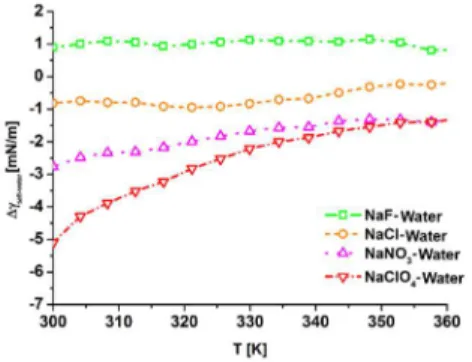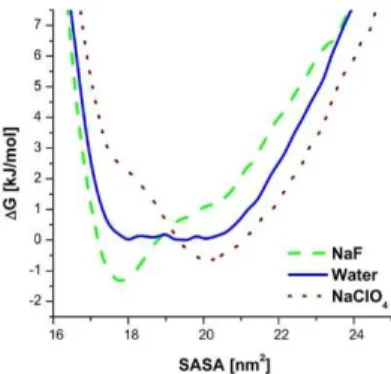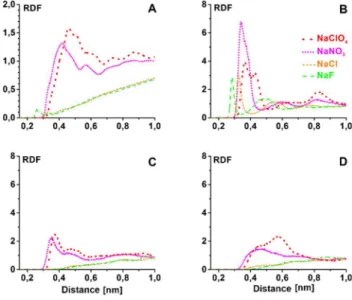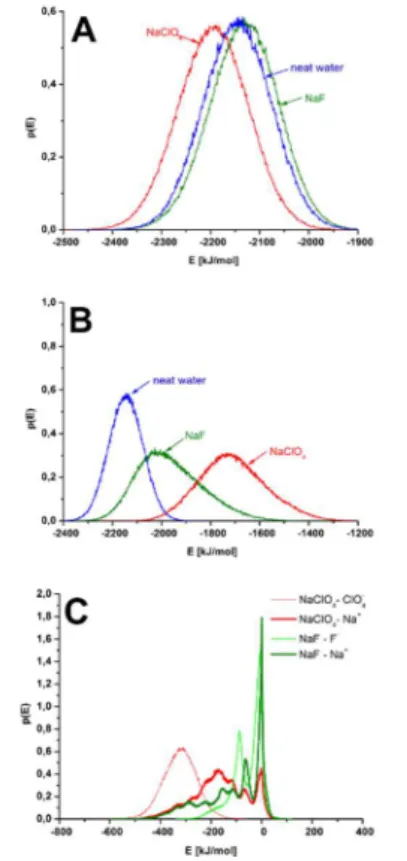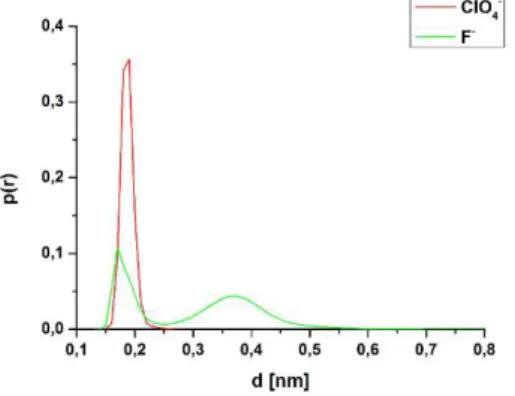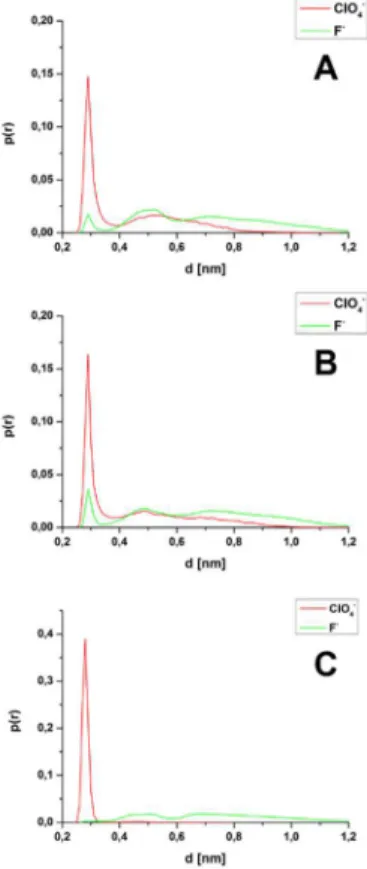Investigation of the Hofmeister effect utilizing computational tools
Summary of the Ph. D. thesis
Author: Zoltán Násztor
HAS Biological Research Centre, Szeged, Institute of Biophysics
Supervisor: Ferenc Bogár
HAS-SZTE Biomimetic Systems Research Group
Co-Supervisor: András Dér
HAS Biological Research Centre, Szeged, Institute of Biophysics
University of Szeged Faculty of Science and Informatics
Doctoral School of Physics Szeged
2019
- 1 -
1. Introduction
The notion of Hofmeister effect [1] has been known for more than 100 years. It was first described as a phenomenon concerning the solubility of globular proteins: some salts were found to increase solubility, whereas others decreased it. The ions in aqueous environments change the local water structure and interact with other ions, as well as with other hydrated molecules. Co-soluted ions may weaken or strengthen the interaction between water molecules, furthermore, the H-bond network can also be modified by changing the spatial orientation of water molecules. The ions increasing the strength of H- bonds are called kosmotropes („structure builders”), whereas the ones decreasing it are called chaotropes („structure breakers”) [2]. Hence, Hofmeister effect was associated with the effect of anions on the water structure.
It has been experimentally demonstrated that dominant conformational motions of proteins are “slaved” by their first hydration shell and the bulk solvent [3]. It was later demonstrated that the effects of co-soluted ions - concerning water structure and H-bond strength – are not limited to the alterations of the solubility of proteins.
For instance, such a change in the hydration environment remarkably influences the spatial structure of proteins, the stability of the realized conformations, and, consequently, their corresponding biological activity. Water molecules located in the first- and second hydration shells have an increased impact on the formation and stability of different conformations [4]. Kosmotropic ions usually increase the activity of enzymes and their conformational stability, while the chaotropic ones exert opposite effects.
Despite their widespread occurrence and the extensive theoretical and experimental research efforts, a comprehensive interpretation of the Hofmeister effect isn’t available till the present day.
- 2 -
In a recent work, Dér and his co-workers [5, 6] demonstrated that a unified, phenomenological formalism based on the protein-water interfacial tension, could provide a qualitative description of many Hofmeister effect related phenomena. Their main result was that kosmotropic ions could increase interfacial surface tension, while chaotropic ones could decrease it compared to the neat water case, which also manifests in the investigated system’s free energy change.
However, direct evidence to the Hofmeister effect related, salt- induced interfacial surface tension changes was not available. This is one of the questions we addressed utilizing the tools of classical molecular dynamics.
Choosing the tc5b miniprotein [7] as a model system, Hofmeister effect related investigations were carried out. The Trp-cage, or tc5b, miniprotein was a subject of wide-range computational and experimental examinations. This model system consists of only 20 amino acids, it’s popularity is due to the small size, the stable and compact spatial structure, and the latter one’s thermal sensitivity. In the course of our investigations, the Hofmeister-active salt induced conformational fluctuations were examined, and also the solvent accessible surface area (SASA) changes were determined. Using the SASA quantity, the interfacial surface tension changes, predicted by Dér and co-workers in the interfacial tension concept, were calculated.
In order to describe the occurring microscopic mechanisms of the Hofmeister effect, an in-detail investigation of the interfacial region was carried out. The properties of water molecules located at the protein-water interface, and the ion distributions were derived. Aside from the ion accumulation-depletion features, mapping of protein-ion interactions proved to be an important tool with respect to the atomic- level interpretation of the Hofmeister effect. In the course of this, we used the supportive results of Collins and his co-workers [8], as well.
- 3 -
2. Methods
Computational modeling of biomolecular systems is fundamentally based on statistical thermodynamics. The goal is to originate results describing real-world systems by the investigation of simulation systems of very limited size. The results presented in this work were obtained by using the tools of molecular dynamics (MD). Every classical MD simulation is based on the step-by-step integration of the Newtonian equation of motion using numerical methods, or rather the calculation of the spatial coordinates and velocities of every atom. In the course of these simulations, there are constant parameters belonging to atoms of the investigated molecules, such as mass, partial charge, or van der Waals radius. However, considering polarization and charge transfer effects in most of the cases isn’t possible. The most remarkable advantage of MD methods - in contrast to quantum mechanics-based simulations - is their applicability for mapping the conformational space in case of large systems, such as a protein in a certain hydration environment.
The preparation, running, and partially the evaluation of the simulations was done by using the GROMACS package [9]. The simulation systems contained one tc5b miniprotein in a cubic simulation box with 4,18 nm side length. The TIP3P [10] water model was applied, approximately 2200 water molecules were present in the system. The simulations were done in the presence and in the absence of selected Hofmeister-active salts. In the course of the simulations, single- and polyatomic Hofmeister-active ions were considered in 1 M concentration. Conformational ensembles belonging to different temperatures were derived using REMD (replica-exchange MD) calculations, which were used to examine spatial stability, and to derive SASA values. Besides, NPT (constant pressure, temperature and particle number) simulations were carried out to investigate the features of the miniprotein – hydration environment interface.
- 4 -
The REMD simulations were done on 32 different temperatures in a 300-450 K temperature range. The simulation time was 600 ns and the integration time step was 1 fs. The exchange between the replicas was attempted at every 2000th step (after 2 ps). Only the last 300 ns of trajectories belonging to the 300-360 K temperature range was considered in the course of evaluation. The Amber ff99SB-ILDN [11]
force field was applied, considering the electrostatics ,a 1,0 nm cutoff distance was used together with the PME method. The v-rescale method was selected for the temperature coupling, whereas the Parrinello-Rahman barostat was used for pressure coupling. Covalent bonds containing H atoms were constrained by the LINCS algorithm [12], in order to make the running of MD simulations more stable.
In the NPT calculations, the spatial structure of the tc5b miniprotein was fixed by using a harmonic constraint with a force constant of 103 kJ mol-1 nm-2. The simulation time was 100-ns long, and all the other relevant MD parameters were identical to the ones used during REMD simulations, the simulation temperature was 300 K. Aside to these simulations a third group of NPT runs were also carried out. The model systems for these simulations contained only water molecules and the selected salts in 1 M concentration. The goal of these calculations was to identify the hydration features of ions, and also to investigate the properties of water molecules located in the first and second hydration shells of these ions.
3. Scientific Results
In this section, the main scientific results of the thesis will be reviewed, summarized in five thesis points. At the end of each thesis point, a reference is given to the research paper containing the corresponding statements.
- 5 -
T1. We showed that the tc5b miniprotein together with the selected simulation preferences represents an appropriate model to identify structural and stability alterations induced by the investigated ions, which are in compliance with their position in the Hofmeister series. [P1]
We selected the average solvent accessible surface area (SASA) value as the quantity characterizing the state of the miniprotein. As it can be seen in Figure 1.A, in the presence of chaotropic ClO4- and NO3-
anions, the average SASA is increased by 1,5 and 1 nm2, respectively, at 300 K, compared to the neat water case. The addition of the Hofmeister-neutral NaCl salt somewhat increases the average SASA value, showing a slight chaotropic character, while in the presence of F- ions an approximately 0,2 nm2 decrease could be detected.
Figure 1. The average SASA (A) and it’s fluctuation (B) as the function of temperature for every investigated system.
Root mean square (RMS) fluctuations of SASA (Figure 1.B) show a similar tendency in a wide temperature range (300−345 K):
Fuctuations are higher for the chaotropic and smaller for the kosmotropic anions, than those calculated for the neat water case.
Considering the average SASA values, it could be deduced that each ion altered the corresponding conformational ensemble in accordance with the ions’ position in the Hofmeister series, i.e. ions exerting a chaotropic effect increased the ratio of „opened” structures, whereas the kosmotropic NaF salt had an opposite effect. These findings are in
- 6 -
line with the interfacial tension concept suggested by Dér and co- workers.
In a recent study, Tadeo et al. [13] used the immunoglobulin G binding domain of protein L from Streptoccocus magnus as a model system, and investigated the effect of Hofmeister-active anions on protein stability using CD and fluorescent spectroscopy. This system shows several similarities to the tc5b miniprotein, it has stable secondary and tertiary structures, and it contains α-helical secondary structure elements. The hydrophobic interaction plays an important role in its stabilization as well. Tadeo et al. used lysine to glutamine mutations to modify the apolar surface area of the protein. For all investigated mutants, they detected structure stabilization using the kosmotropic F−, and structure destabilization in the case of chaotropic NO3− and ClO4− ions.
T2. In our model system, from the SASA changes, we calculated the interfacial surface tension changes induced by the presence of the investigated Hofmeister-active salts. We showed that these simulation results are in accordance with the interfacial tension concept suggested by Dér and co-workers [5, 6]. [P1-P2]
From the results presented in Figure 1, using simple numerical integration, we obtain the interfacial surface tension changes induced by the investigated ions (𝛥𝛾 ). As it can be seen in Figure 2, at 300 K, the chaotropic ClO4- and NO3- anions decreased the interfacial tension by approximately 5,2 and 2,7 mN/m, respectively.
The Cl- ions decreased, while the kosmotropic F- ions increased the value of γ by approximately 1 mN/m. With increasing temperature, the deviations from the neat water−protein interfacial tension decrease, as at higher temperatures the structure of tc5b is destabilized, and the influence of surface-induced fluctuations becomes relatively smaller compared to the temperature-induced ones. In the 300-360 K temperature interval, the ion-induced changes
- 7 -
of the surface tension show a Hofmeister-series consistent ordering.
In accordance with the predictions of the interfacial tension concept, the chaotropic ions decrease the values of 𝛾, whereas the kosmotropic ions increase it compared to the neat water case.
Figure 2. Protein-water interfacial surface tension changes with respect to the neat water case induced by NaF, NaCl, NaNO3 and NaClO4 salts.
The existence of a U-shaped free-energy landscape is an important assumption in the interfacial tension concept. Using the conformational ensembles of the REMD simulations, the free energy landscape (∆𝐺 ) over the total conformational space can be obtained from the probability distribution of states:
∆𝐺(𝑅) = −𝑘 ∙ 𝑇 ∙ 𝑙𝑛 𝑃(𝑅) (1)
Here R represents a point of the conformational space, 𝑃(𝑅) is the probability of this state, 𝑘 is the Boltzmann-constant, and T is the absolute temperature. By fitting a sigmoid function with respect to the average helicity in the neat water case, the transition temperature was derived, which proved to be 340,47 K. Using the conformational ensembles belonging to this temperature, the free-energy profiles were
- 8 -
calculated for the neat water case and for the NaClO4 and NaF containing systems.
Figure 3. Free-energy profiles of the tc5b miniprotein for the neat water case and for the NaF and NaClO4 salt containing cases at 340,47 K.
As it can be seen in Figure 3, at the transition temperature of the neat water case, the corresponding free-energy landscape is approximately U-shaped, with a relatively flat and horizontal bottom in the 17,5-21 nm2 interval. The chaotropic perchlorate ion adds a positive, while the kosmotropic fluoride ion a negative slope to the baseline, shifting the ensemble towards more open and more closed conformations, respectively. Despite their qualitative nature, these results present a strong support for the main conclusions of the theory suggested by Dér and co-workers.
T3. At the interface between the tc5b miniprotein and its hydration environment, we identified the accumulation features of the selected Hofmeister-active ions, and the corresponding changes regarding the orientation dynamics of interfacial water molecules. [P1]
Radial distribution functions (RDF) were applied to investigate the interfacial ion distribution; the results are shown in Figure 4. It could be deduced that the chaotropic ClO4- and NO3- ions accumulate at the
- 9 -
protein-water interface, in contrast to the kosmotropic F- and the Hofmeister-neutral Cl- ions that are depleted from this region. The local concentration of the chaotropic ions is considerably higher already in the closest interfacial region (0,3-0,5 nm) than the same quantity for F- and Cl- ions. We also investigated the protein surface regions around different surface charges, separately. Figure 4.B−D shows the radial distribution function of anions at the characteristic regions having different surface charges: (B) the headgroup of positively charged Lys8; (C) the N atom of the NH group of the Gly15 backbone; (D) a carbon atom of the apolar ring of Pro12.
Figure 4. RDFs of cosoluted anions around the heavy atoms of the whole peptide (A), the N atom of the charged Lys8 side chain (B), the H-bond donor N atom of Gly15
(C), and a C atom of the apolar ring of Pro12 (D) for the tc5b miniprotein.
The F- and Cl- ions accumulate only at region B, having the largest surface charge, and expelled from the other regions with smaller positive surface charge. The ClO4- and NO3- ions accumulate at all
- 10 -
three regions, and their local density seems to correlate with the magnitude of the surface charge density. Accumulation of chaotropic ions at the protein surface has been observed also experimentally, furthermore – according to the previous section – their presence decreases the protein−water interfacial tension, in accordance with the predictions of Dér and co-workers.
In order to examine the water molecules located at the interfacial region, the first solvation shell of the miniprotein was identified with the help of the RDF of water oxygen atoms around the surface of the miniprotein.
Figure 5. Orientation autocorrelation function of water molecules having their O atoms at a distance (A) <0.23 nm (first set) and (B) between 0.23 and 0.31 nm (second
set) from the fixed tc5b surface for neat water and for the cosoluted salts.
Taking into account the RDF of the water molecules in the first hydration shell, they could be divided into two distinct groups. The
- 11 -
first set of water molecules belonging to the first maximum of the curve are turning their 𝑂 − 𝐻 bonds away from surface, thus acting as acceptors - with respect to H-bonds -, whereas the water molecules of the second set act as donors, turning their H atoms towards the surface.
The water molecules in the first set are close to positively charged regions, where chaotropic anions also accumulate. The members of the second set are placed dominantly around the remaining part of the miniprotein surface. As it is presented in Figure 5, for the possible acceptors, the orientation autocorrelation functions show a Hofmeister-series consistent ordering. The chaotropic ions increase, while the kosmotropic F- and the Hofmeister-neutral Cl- ions decrease the average orientation flexibility of water molecules, compared to the neat water case. Considering the second set of water molecules (possible donors), each Hofmeister-active ion slows down the reorientation process. It could be inferred, that the changes of the water dynamics in the first hydration shell are indicative of structural changes in the H-bonded water network, as it has been observed experimentally, too, in the case of water solutions of Hofmeister salts [14].
T4. We determined the changes in the interaction between the hydrated miniprotein and its environment, in the absence of Hofmeister-active ions, as well as in the presence of chaotropic perchlorate ions and kosmotropic fluoride ions. Major differences were identified with respect to the miniprotein-environment interaction energy distribution, and to the distance distribution of the closest ions. [P3]
The chaotropic and kosmotropic ions either accumulate at the protein- water interface, or they are depleted from this region (Figure 4.). In either case, the interaction of the miniprotein with its environment is modified. To evaluate this change, we calculated the sum of Coulomb and van der Waals interaction energies of the miniprotein with the solvent, with and without the cosoluted salts. In Figure 6.A, the
- 12 -
distribution of interaction energy, calculated between the miniprotein and the whole hydration environment, is shown. It could be deduced that adding NaClO4 to the solution, the curve is shifted toward the more negative, while in the case of NaF toward the positive direction with respect to the neat water case, which indicates strengthening and weakening effect, respectively.
Figure 6. Distribution of interaction energy (in %) of protein with its environment for NaF, NaClO4 and neat water cases. Calculated between tc5b miniprotein and (A)
water and ions; (B) water and (C) ions.
- 13 -
Zhao et al. pointed out [15] (using explicit-water MD simulations) that the interaction energy of a protein with its environment shows a negative correlation with structural stability. Appling this to the energy distribution presented in Figure 6.A, it could be deduced, that the presence of perchlorate ions induce destabilization, in contrast to fluoride ions that increase stabilization. The water-miniprotein interaction energy becomes smaller in magnitude for both investigated salts, compared to the neat water case (Figure 6.B). The interaction energy decrease is smaller for NaF than for NaClO4. The contribution of the ions is considerably larger in magnitudein the case of NaClO4
than for a NaF, for both anions and cations (Figure 6.C).
The distributions of energies for the kosmotropic and chaotropic ions show a different character (Figure 6.C), which indicates major differences between the interaction patterns of these two ions. The identification of these patterns was done by utilizing DDCI curves (distance distribution of closest ions).
Figure 7. Distance distribution of the closest F- and ClO4- anions around the tc5b miniprotein.
The calculation of DDCI curves was performed taking into account the whole surface of the miniprotein (Figure 7), and at selected
- 14 -
interaction sites of tc5b. These latter calculations were done: for the side chain N atom of Lys8, the side-chain N atoms of Arg16 residues, and the N atom of the α amino group at the N-terminus (Figure 8).
Aside from the surface-exposed charge, other factors - for instance surface geometry - also play an important role in the realization of certain protein-ion interaction types.
Figure 8. A vizsgált anionok DDCI görbéi: (A) Lys8-; (B) Arg16 oldallánc töltött N atomjaira és (C) az N-terminális NH3+ csoportjának N atomjára vonatkoztatva.
Taking into account the DDCI of perchlorate ions, a “single-peaked”
character can be seen (Figure 7), which indicates a direct, CP (contact
- 15 -
pair) type protein-ion interaction for the chaotropic ClO4- ion. Most probably this is a consequence of the CP-type interaction formed at the N-terminal (Figure 8). On the contrary, in the presence of F- ions, the DDCI curve has two distinct maxima considering the whole surface (Figure 7). The second one indicates an at least partial preservation of the solvation shell of fluoride ions, thus the formation of an SSP type (solvent-separated pair) interaction.
Considering the other interaction sites (Figure 8), another, less sharp maximum could also be identified for the F- ions, which indicates the formation of an at least two water-molecule mediated interaction type (2SP – two solvent pair). In general, for all the investigated sites, the water-mediated interaction types were the most favored ones by the F- ion. The pair-forming propensities of the investigated ions shown in Figures 7-8 are in line with Collins’s rule [8]. According to this empirical law, an anion and a cation prefer pair formation in water solution, if both of them are either kosmotropic or chaotropic. The above-presented features of the protein-ion interactions and ion accumulation provide explanation also to the differences of the interaction energy profiles presented in Figure 6.C. For the ClO4- ions, the CP-type interaction is the most preferred at every investigated interaction site, thus the corresponding interaction energy distribution spans from -100 kJ/mol to -600 kJ/mol. On the contrary, the F- ions favor the water-mediated interaction types (SSP, 2SP) compared to the CP-type, at every investigated interaction site. Furthermore, this finding is also valid for the whole protein surface, therefore, in the majority of the simulation, at least one F- ion could be found around the miniprotein sharing its hydration shell with the tc5b. This feature is in accordance with the corresponding protein-ion interaction profile (Figure 6.C), where near-zero values dominate.
- 16 -
T5. During the course of computational simulations, the processes induced by the kosmotropic fluoride and chaotropic perchlorate ions with respect to the hydrated tc5b miniprotein were artificially separated into two subsequent parts. In the first, promotion phase, the equilibrium ion-water distribution, and hydration changes were determined using a fixed miniprotein geometry, while in the second, rearrangement phase, other changes accompanying the adaptation of the protein structure to the modified environment were followed. Based on these results, we identified the most decisive steps during the chaotropic destabilization and kosmotropic stabilization of the tc5b miniprotein. [P3]
In order to identify the mechanisms playing important roles regarding the Hofmeister effect, the hydration features of the ions were investigated. The hydration process of the miniprotein was separated into two subsequent parts. In the first part, harmonic constraints were applied to keep the miniprotein’s spatial structure fixed. In this way, conformational transitions and side chain fluctuations were hindered, thus equilibrium ion distributions could be determined at the protein- water interface (“promotion phase”). By omitting the constraints, the tc5b miniprotein could adapt to the changed hydration environment, thus structural and spatial stability changes could occur (“rearrangement phase”).
Chaotropic destabilization
In the promotion phase, less water molecules could be found in the first hydration shell of the miniprotein in the presence of perchlorate ions, as compared to the neat water and NaF salt containing cases.
Furthermore, a significant portion of water molecules were found to be reoriented due to the presence of chaotropic ions. Consequently, the protein-water interaction decreases (Figure 6), likewise the strength of H-bonds formed between interfacial water molecules (Figure 5). It was the most remarkable among strongly bound water molecules, stabilizing the spatial structure of the protein, which
- 17 -
facilitates loosening of the conformation. In spite of these changes, the coupling strength between the tc5b and its hydration environment increases (Figure 6). This also indicates a decreasing structural stability, which is in line with the experimental facts [16], and with our results (Figure 1). During the transition from the promotion to the rearrangement phase, the average number of water molecules in the first hydration shell of the miniprotein slightly increases, while this quantity sharply decreases for the perchlorate ions. Despite the increased SASA (Figure 1), there are less water molecules in the first hydration shell of the miniprotein compared to the neat water case.
This feature is in accordance with the favoring of the CP-type protein- ion interaction type, observed for the perchlorate ions (Figure 7-8). As a consequence, conformational fluctuations are increased, which opens the way for further dehydration of the perchlorate ions on the increased interfacial surface area. This dehydration could be considered as the main driving force of chaotropic destabilization.
Kosmotopic stabilization
Remarkably strong first- and well-defined second hydration shells are maintained by the kosmotropic fluoride ions, which overlap with the miniprotein’s hydration shell. The kosmotropic F- ions hardly have direct interactions with the positively charged sites of the protein surface. This observation is supported by the high probability of SSP and 2SP type interactions in this case (Figure 7-8). Due to the favoring of water-molecule mediated interaction types, the reorientation of the interfacial water molecules becomes slower (Figure 5), and the first hydration shell of tc5b becomes „stiffer”. The coupling strength between the tc5b and water molecules also decreases (Figure 7), due to the water molecules being oriented in a way which makes their interaction with the miniprotein disfavored. Overall, the interaction energy between the miniprotein and its hydration environment also decreases compared to the neat water case, and the spatial structure of tc5b becomes more stable. With respect to the interfacial surface
- 18 -
tension concept, this means a decreased average SASA (Figure 1) and a Δγ of positive sign (Figure 2). In contrast to the perchlorate-ion containing case, no major dehydration is experienced, neither by the miniprotein’s nor by the ions’ first hydration shells.
Publications
Research papers related to the thesis:
P1. Bogar, F., et al. (2014). "On the Hofmeister Effect: Fluctuations at the Protein Water Interface and the Surface Tension." Journal of Physical Chemistry B 118(29): 8496-8504.
P2. Nasztor, Z., et al. (2016). "The interfacial tension concept, as revealed by fluctuations." Current Opinion in Colloid & Interface Science 23: 29-40.
P3. Nasztor, Z., et al. (2017). "Ion-induced alterations of the local hydration environment elucidate Hofmeister effect in a simple classical model of Trp-cage miniprotein." Journal of Molecular Modeling 23(10).
Additional research papers:
1. Bogar, F., et al. (2015). "Opposite effect of Ca2+/Mg2+ ions on the aggregation of native and precursor-derived A beta(42)." Structural Chemistry 26(5-6): 1389-1403.
2. Horvath, J., et al. (2016). "Characterizing the Structural and Folding Properties of Long-Sequence Hypomurocin B Peptides and Their Analogs." Biopolymers 106(5): 645-657.
3. Nasztor, Z., et al. (2013). "Structural Characterization of the Short Peptaibols Trichobrachins by Molecular-Dynamics Methods."
Chemistry & Biodiversity 10(5): 876-886.
4. Nasztor, Z., et al. (2015). "In silico conformational analysis of the short-sequence hypomurocin a peptides." Int J Pept 2015: 281065.
5. Nasztor, Z., et al. (2015). "Studying the Structural and Folding Features of Long-Sequence Trichobrachin Peptides." Chemistry &
Biodiversity 12(9): 1365-1377.
- 19 -
References
1. Hofmeister, F., Zur Lehre von der Wirkung der Salze. Arch. Exp. athol.
Pharmakol., 1888. 24: p. 247-260.
2. Collins, K.D. and M.W. Washabaugh, The Hofmeister effect and the behaviour of water at interfaces. Q Rev Biophys, 1985. 18(4): p. 323-422.
3. Frauenfelder, H., S.G. Sligar, and P.G. Wolynes, The Energy Landscapes and Motions of Proteins. Science, 1991. 254(5038): p. 1598-1603.
4. Ball, P., Water as an active constituent in cell biology. Chemical Reviews, 2008. 108(1): p. 74-108.
5. Der, A., et al., Interfacial water structure controls protein conformation. J Phys Chem B, 2007. 111(19): p. 5344-50.
6. Neagu, A., M. Neagu, and A. Der, Fluctuations and the Hofmeister effect.
Biophysical Journal, 2001. 81(3): p. 1285-1294.
7. Neidigh, J.W., R.M. Fesinmeyer, and N.H. Andersen, Designing a 20- residue protein. Nature Structural Biology, 2002. 9(6): p. 425-430.
8. Collins, K.D., G.W. Neilson, and J.E. Enderby, Ions in water:
Characterizing the forces that control chemical processes and biological structure. Biophysical Chemistry, 2007. 128(2-3): p. 95-104.
9. Hess, B., et al., GROMACS 4: Algorithms for highly efficient, load- balanced, and scalable molecular simulation. Journal of Chemical Theory and Computation, 2008. 4(3): p. 435-447.
10. Jorgensen, W.L., et al., Comparison of Simple Potential Functions for Simulating Liquid Water. Journal of Chemical Physics, 1983. 79(2): p.
926-935.
11. Lindorff-Larsen, K., et al., Improved side-chain torsion potentials for the Amber ff99SB protein force field. Proteins-Structure Function and Bioinformatics, 2010. 78(8): p. 1950-1958.
12. Hess, B., et al., LINCS: A linear constraint solver for molecular simulations. Journal of Computational Chemistry, 1997. 18(12): p. 1463- 1472.
13. Tadeo, X., et al., Protein Stabilization and the Hofmeister Effect: The Role of Hydrophobic Solvation. Biophysical Journal, 2009. 97(9): p. 2595-2603.
14. Leberman, R. and A.K. Soper, Effect of High-Salt Concentrations on Water-Structure. Nature, 1995. 378(6555): p. 364-366.
15. Zhao, L., W.Z. Li, and P. Tian, Reconciling Mediating and Slaving Roles of Water in Protein Conformational Dynamics. Plos One, 2013. 8(4).
16. Heyda, J., et al., Urea and Guanidinium Induced Denaturation of a Trp- Cage Miniprotein. Journal of Physical Chemistry B, 2011. 115(28): p.
8910-8924.
